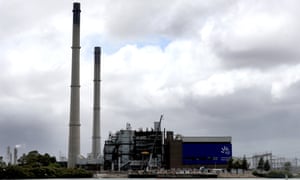Report challenges justification for government underwriting of up to five new gas-fired generators
Australia’s existing gas power plants are running well below capacity, challenging the justification for a Morrison government program that may support up to five new gas-fired generators, according to a new report.
Energy analyst Hugh Saddler, from Australian National University’s Crawford school of public policy, found the combined-cycle gas plants in the national grid – those expected to be available near constantly, sometimes described as “baseload” – ran at just 30% capacity across the past 18 months.
The Australia Institute, the thinktank that publishes Saddler’s monthly energy audit which includes the gas analysis, said it suggested the government’s commitment to underwrite new gas generators made little sense, and if it wanted to increase supply it should find ways to get the current fleet to operate at greater capacity.
Energy analyst Hugh Saddler, from Australian National University’s Crawford school of public policy, found the combined-cycle gas plants in the national grid – those expected to be available near constantly, sometimes described as “baseload” – ran at just 30% capacity across the past 18 months.
The Australia Institute, the thinktank that publishes Saddler’s monthly energy audit which includes the gas analysis, said it suggested the government’s commitment to underwrite new gas generators made little sense, and if it wanted to increase supply it should find ways to get the current fleet to operate at greater capacity.
Saddler said gas ran well below capacity largely because it was the most expensive form of electricity. Gas is sometimes called on by the Australian Energy Market Operator (Aemo) to boost grid security, but Saddler said this role was expected to decline as new high-voltage interconnectors were built between states and regions.
He said the idea gas would be a transition fuel in the Australian market was nearly 20 years out of date. “The ISP results [from Aemo’s integrated system plan for the grid] show very clearly there is a transition from coal to renewables without going via gas under all the scenarios,” Saddler said.
A spokesman for the emissions reduction minister, Angus Taylor, said the Aemo modelling highlighted demand for gas generation as a balance to variable renewable generation was expected to increase. He emphasised that the gas projects shortlisted for the government underwriting program were not combined cycle plants, but “highly flexible, fast start” technology that were particularly well suited to complementing renewable energy.
Saddler said the first point was misleading. He said the Aemo modelling suggested gas generation would decline over the next decade even as coal plants closed before rebounding in the late 2030s to a level that would still be less than today.
Saddler said the flexible gas plants already in the grid were also running well below capacity. He pointed to 31 January this year, the second highest day for electricity demand on record, when the maximum gas generation from both combined-cycle and flexible generators reached 7.6 gigawatts, well below the grid’s total gas-fired capacity of 11.4 gigawatts .
Richie Merzian, Australia Institute’s climate and energy director, said the grid’s gas plants were mostly built 10 to 20 years ago, when it was assumed the price of gas would come down and that gas would play a significant role as a transition fuel during the shift from fossil fuels to clean energy.
“In reality, gas is expensive, it’s high-polluting and, as this research shows, it is under-performing,” he said. “Given this, why would we underwrite new gas-fired plants?”
Gas-fired power is usually said to have about half the emissions of coal-fired generation, but some studies have found this does not factor in the amount of methane – a highly potent, but relatively short-lived, greenhouse gas – that leaks into the atmosphere during extraction and from pipelines.
According to Aemo’s modelling, the grid is likely to need between 5 gigawatts and 21 gigawatts of new “flexible, dispatchable” generation by 2040. It lists large-scale pumped hydro and battery storage, small-scale batteries and demand reductions programs as likely sources.
It found new, flexible gas generators could also play a role “if gas prices materially reduce”. The wholesale price of gas has roughly tripled over the past decade.
Taylor’s spokesman cited a recent grid report card by the government’s Energy Security Board that raised concerns about maintaining security and reliability when wind and solar were not available. “The government has consistently prioritised action to encourage new, reliable supply, including pumped hydro, like Snowy 2.0, and [flexible] gas,” he said.
Tony Wood, the energy program director at the Grattan Institute, said the underwriting program was a bad idea as it distorted the market and discouraged private investment, and a carbon price remained the best way to drive a shift to net zero emissions.
He said gas was likely to play a role in the transition to a clean grid, but decisions on whether to invest in gas, or any technology, were best made by energy companies in the context of a clear climate policy.
“Then if people want to invest in new gas-fired power stations to balance the system and they are prepared to pay for that and think they can make that work, I don’t see any reason why they shouldn’t do that,” Wood said. “But the government shouldn’t be paying for it or underwriting it.”

No comments:
Post a Comment